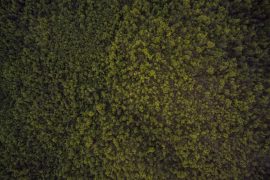CAUSE WE IS LANGUAGE AND WE IS WORDTo talk about the poems in Sami Miranda’s We Is is to talk about a poetry that uses its language with such restraint that each word spreads like a drop of blood in water; it is to talk about a poetry that pays homage to community, to the poet’s Boricua heritage, and the heritage of displacement. Though by no means does this represent the collection’s full thematic range, it is its main thrust. Terse lines, straightforward diction—an almost imagist use of language—characterize the poems and focus the reader’s attention. Take “Cuántos somos?”: How many are we? A clearheaded woman counts her children so she knows each has been spared a conversion into mourning. A question left hanging and a sentence broken into five seemingly end stopped lines make up the entire poem, and leave no doubt about their meaning. Formal choices such as not making any assumptions about the woman’s feelings nor employing metaphor (if not the poem’s form itself) convey utmost respect for her dignity and plight. She faces an existential threat at every turn, at every turn of the line, the suspension building through two enjambments up to the powerfully compressed “conversion into mourning.” Four desert object poems deliver the same fierce poignancy, adding a bare minimum of figures of speech to give the reader a sequence of terrifying instances of synecdoche: four personal objects abandoned in the desert by migrants. Each poem is an intimate exchange, not unlike a soliloquy, the speaker disembodied. Here is “Desert Object #1: Zapatos”—note the possible homophone soles/souls that the poem evokes here to great effect, and the explosive starkness of the facts: Shoes, a child’s size 3. Worn, they know more miles than they should. How old were you? Do the number of holes in the soles match your losses? Immediately preceding this series, “Desert” prepares the reader for what is to come. In its entirety, the poem reads: “This sun wants to melt me / into sands that would cover the reminders of me. / Wants to bleach bones left exposed, / turn them into landmarks / passersby will ignore.” The sun and the desert are hostility personified—the threat of absolute annihilation. Note ‘remainder/remains’ echoing in “reminders.” In “Waiting for Her Decision,” the sea is similarly personified: I am here, reaching through a sea that did not invite me in. A foreign object in her blue, wrenched back and forth waiting to be pulled away. The hostess I have forced myself on, hostile then cradling hasn’t decided whether to spit me out or swallow me into her embrace womb-like, eternal. As readers we are meant to trust these poems’ words: there is no escape into ironic distancing, no ambiguity, nor any reprieve that a rich imagery might provide. These poems mean what they say with unadorned directness, and they hold a reader’s gaze without flinching. Originally from the Bronx, Sami Miranda lives in Washington D.C., where he teaches high school students, writes, paints, embroiders, prints, carves, or works in mixed media. He is as much a visual artist as a poet and performer whose various art forms feed off of each other. We Is, his first full-length collection, illustrates that. His striking prints punctuate the book, not as decorative foil—and only loosely as thematic dividers—but complementing the poems and in dialogue with them. Unlike photographs might, they do not document. The same deft hand that cuts the prints seems to shape the poems. It takes virtuosity to determine what is quintessential and make it instantly compelling with a few well-placed cuts. In this the prints underpin the poems’ masterful directness. “Burning Rolling Pins” could serve here as ars poetica. The poem’s last stanza distills the speaker’s artistic goal: I place a torch to the stories I have carved watch the blue flame eat away at the tales erasing any fiction I might have included in the original telling. As the collection progresses, it moves from the physical landscape of migration to the poet’s community or communities, and with that to the emotional landscape of displacement, the striving to find rootedness in that very displacement. Music appears—as concrete subject and symbolically as cultural fabric—and the reader meets a group of sometimes recurring figures like “Spanish Joe” or “Chino Bicicleta,” the bicycle mechanic. These homages can be based on shared legends, actual friends, or a relative—the lines are blurred. They are all set in a mythic present, and each figure is portrayed with the same restraint that characterizes the collection and with loving playfulness, as in “Things Spanish Joe Learned from Salomé about Playing Bass”: Clave You don’t need to play the clave. You need to hear it, you need to feel how it fits. Tumbao A tumbao needs to be carried like the scent of tobacco and cologne on a sharply ironed güyabera Baile When you play it loose, you will move bottoms out of chairs. Make them sway. Suéltate y tócalo así The tone is one of erotic banter, the pace dance-like, and, as is often the case throughout We Is, wordplay is possible but not forced upon the reader: clave ‘key’—as it does in English—refers to the musical key as well as to what is essential. In “Barracuda Meets the Woodcarver’s Knife,” the poet recurs to a cinematographic technique that slowly narrows the focus to one, burning point, heightening the poem’s sense of foreboding up to culminating in slow-motion brutality and a silent scream: Before Barracuda patted the woodcarver’s wife on the head in her own home he should have known the woodcarver would find it offensive men around a pool table never take anything lightly a hand pulling a gun from a waistband is never faster, than one gripping a freshly sharpened knife an open wound makes a finger forget how to pull a trigger a silent .38 turns the quiet of a knife cutting through flesh into the wail of a mouth sliced open by pain. In the story it tells, this poem recalls a ballad, thus, reenacting and reinforcing a community’s and/or a people’s bonds by the retelling, ensuring the continuity of a shared memory. It is an identity affirming exercise, which, incidentally, also delineates the boundaries of one community within another. The poem following immediately afterward, “Room Change,” pivots to the present day, and is hopeful in tone. The speaker stands in the room where the preceding events may or may not have taken place in an unspecified past, “[t]he billiard table is gone,” and the “room once filled / with a diaspora-accented Spanish, / liquor, the violence of displacement, / is home to music.” It “is a quiet space now,” where daughters grow into instruments of their choosing and notes gather into a tune that calms the past. The frequent use of enjambment in this poem gives a sense of layers—the past echoing?—and creates such striking double meanings as “liquor, the violence of displacement.” The nostalgia expressed by the collection’s various figures is profound and so is their longing for rootedness. A sequence of prose poems in different women’s voices expresses this with special urgency. A reading of the titles alone conveys the heartbreak: “Norma Remembers Warmth,” “Tía Mina Goes to the Beach to Feel Light Again,” “Josefina Goes to the Rooftop to Remember Home.” Nostalgia is complicated by the fact of finding oneself in communities of disparate cultural heritages, whether received or aspired to, while united in a shared fate of displacement, far or nearby family and friends. We Is doesn’t shirk from depicting the tensions arising from clashing or competing cultural identities nor the complexity of shifting boundaries, and stops well short of reducing the idea of communality to a romantic overarching concept. In the words of “This Ain’t Mambo”: “[t]he mixing is not accepted by either side, / the dead are dead // and the living / are dancing a dance / they never figured out / no one was meant to lead.” We Is establishes as well as depicts community. Its speaker adopts many voices in the process, a formal choice which may partly be rooted in the wish to reinforce cultural identity and a feeling of duty towards one’s origins, and the tension between the two. In an organic meander, the collection slowly builds up to its last poem, “We Is,” by which time instances of playful terseness have the reader alerted to the possibility that “we is” can be read as a stand-alone statement and/or as the beginning of a list of explorations of a specific “we.” “We Is” is in fact a list poem. That it is also the title of the collection is an intriguing choice, as it seems to confirm the poet’s toying with a reader’s expectations and assumptions. We Is ends by opening—what initially seems to be a closed statement or a simple list of descriptions—to a panorama of wonder and a question that implicate the reader. What does “we” mean? “We Is,” the poem, resounds with all the voices preceding it, and the book I hold in my hands with their poetry. Let it change the color of your water too, and let’s hope that there will be much more to come from this poet. “Where are you headed?” my friends ask. A state of mind, where plena always comes to my rescue banging out the news from el barrio, o Loisaida o el Bronx. All places I run to, then from, then back to again borderless. (from “Looking for My Citizenship”) [/vc_column_text][/vc_column][/vc_row]
We Is





